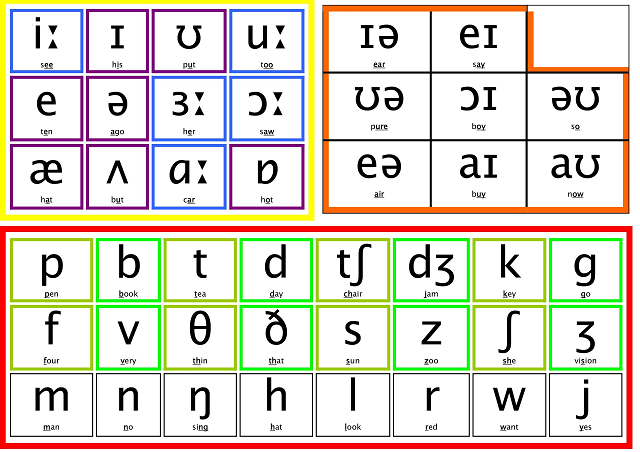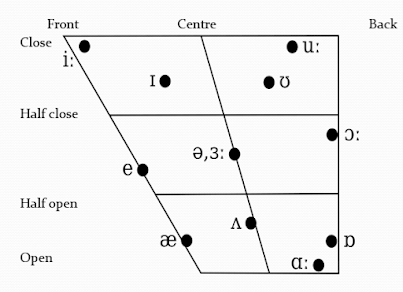Introduction
Phonetics is a component of linguistics that deals with speech sounds. English has 26 letters of the alphabet which represents 44 sounds.
Among the 44 sounds, there are 12 Pure Vowels (monophthongs), 8 Diphthongs, and 24 Consonant Sounds.
Related: How to Spell the Long and Short Vowel Sounds of the English Language
In this post, you will learn the 12 Pure Vowel sounds and 8 Diphthongs with descriptions along with their symbols.
{tocify} $title={Table of Contents}
The English Phonetics
What is a Vowel?
- A vowel is a voiced sound. This sound is produced without a noise component.
- The air which is coming from the lungs without any restrictions is called a vowel.
- There are 20 vowel sounds in the English language. In that, there are 12 monophthongs and 8 diphthongs.
The tongue positions of the English (pure vowels) monophthongs:
The 12 Vowel Sounds:
/i:/
Description:
- The front of the tongue is raised.
- It is raised to a height slightly below and behind the close position.
Spellings:
ee – tree / tri:/, cheese / tʃi:z/, canteen / kænti:n/
e - be / bi:/, these / ði:z/.
ie – field / fi:ld/, piece / pi:s/
ea – tea / ti:/, sea / si:/, leaf / li:f/
>> Click here to watch the video on the /i:/ sound.
/ɪ/
Description:
- A part of the tongue nearer to the Centre than to the front is raised.
- It is raised just above the half-close position.
Spellings:
ɪ – sit / sɪt/, with / wɪð/
e – become / bɪk˄m/,
y – city / sɪtɪ/, sympathy / sɪmpəɵɪ/
a – village / vɪlɪdƷ/, private / praɪvɪt/, cabbage / kæbɪdƷ/
ie – cities / sɪtɪs/, ladies / leɪdɪs/
>> Click here to watch the video on the /ɪ/ sound.
/ʊ/
Description:
- A part of the tongue nearer to the centre than to the back is raised.
- It is raised just above the half-close position.
Spellings:
u – put / pʊt/, full / fʊl/
o – wolf / wʊlf/, woman / wʊmən/
oo – nook / nʊk/, foot / fʊt/, good / gʊd/
ou – could / kʊd/, courier / kʊriə/
>> Click here to watch the video on the /ʊ/ sound.
/u:/
Description:
- The back of the tongue is raised.
- It is raised nearly to the close position.
Spellings:
oo – soon / su:n/, food / fu:d/
o – do / du:/, who / wu:/
ou – soup / su:p/, through / ɵru:/
u –rude / ru:d/, june / dƷu:n/
ew – chew / tʃu:/, jew / dƷu:/
ui – juice / dƷu:z/
ue – blue / blu:/, true / tru:/
oe – shoe / ʃu:/
>> Click here to watch the video on the /u:/ sound.
/e/
Description:
- The front of the tongue is raised.
- It is raised to a position between half-close and half-open.
Spellings:
e – bed / bed /, went / went /
ea – head / hed/, breath / breɵ/
ie – friend / frend /
a – any / enɪ/, many / menɪ /
>> Click here to watch the video on the /e/ sound.
/ǝ/
Description:
- The central part of the tongue is raised.
- It is raised (a) to a point between half close and half-open in non – final positions, (b) to open or half-open position. When the vowel occurs final.
Spellings:
a – about / ǝbǝʊt/, woman / vumǝn/
ar – particularly / pǝtIkjulǝlɪ/, forward / fɔ:wǝd/
e – pavement / peɪvmǝnt/, gentleman / dƷentlmǝn/
er – modern / mɒdǝn/, mother/ m˄ðǝ/
i – possible / pɒsǝbl/, horrible / hɒrǝbl/
o – method / meɵǝd/
or – doctor / dɒktǝ/
ou – famous / feɪmǝs/
u – column / kɒlǝm/
oar – cupboard / k˄bǝd/
our – colour / k˄lǝ/
ure – figure/ fɪgǝ/
>> Click here to watch the video on the /ǝ/ sound.
/3:/
Description:
- The centre of the tongue is raised.
- It is raised to a point between a half-close and half-open position.
Spelling:
ir – bird / b3:d/, girl / g3:l/
er – her / h3:/, serve / s3:v/
ear - heard / h3:d/, earth / 3:ɵ/
or – word / w3:d/, work / w3:k/
our – journey / dƷ3:nI/, courtesy / k3:təsɪ/
>> Click here to watch the video on the /3:/ sound.
/ɔ:/
Description:
- The back of the tongue is raised.
- It is raised between the half-open and half-close positions.
Spelling:
or – born / bɔ:n/, cord / kɔ:d/
aw – saw / sɔ:/, yawn / jɔ:n/
au – fault / fɔ:lt/, cause / kɔ:s/
ou – bought / bɔ:t/, ought /ɔ :t/
a - all / ɔ:l/, talk / tɔ:k/
>> Click here to watch the video on the /ɔ:/ sound.
/æ/
Description:
- The front of the tongue is raised.
- It is raised just below the half-open position.
Spellings:
a – pat / pæt /, hand / hænd /, lamp / læmp /
ai – plaid / plæd /
Example:
bad / bæd /
bat / bæt /
sacks / sæks /
bag / bæg /
back / bæk /
>> Click here to watch the video on the /æ/ sound.
/˄/
Description:
- The Centre of the tongue is raised.
- It is raised just above the fully open position.
Spellings:
u – sun / s˄n /, cut / k˄t /
o – come / k˄m/, front / fr˄nt/
ou – country / k˄ntrɪ/, couple / k˄pl/
oo – blood / bl˄d/, flood / fɪ˄d/
oe – does / d˄z/
>> Click here to watch the video on the /˄/ sound.
/a:/
Description:
- A part of the tongue between the Centre and the back is raised.
- It is raised to the open position.
Spellings:
a – pass / pa:s/, branch / bra:ntʃ/
ar – part / pa:t/, car/ ka:/
ear – heart / ha:t/, hearth/ ha:ɵ/
er – clerk / kla:k/, sergeant / sa:dƷənt/
>> Click here to watch the video on the /a:/ sound.
/ɒ/
Description:
- The back of the tongue is raised.
- It is in a fully open position.
Spelling:
o – hot / hɒt /, dog / dɒg/
a – watch / wɒtʃ/, what / wɒt/
ou – cough / kɒf/,
ow – knowledge / nɒlɪdƷ/
au – because / bɪkɒs/
>> Click here to watch the video on the /ɒ/ sound.
The 8 English diphthongs
A diphthong is a vowel sound with a deliberate glide. It is represented in phonetic transcription by a sequence of two elements (Symbols). The first element shows the position of the organs of speech at the beginning of the glide. The glide terminates on the second element.
A diphthong consists of a single syllable. That is, the vowel glide must be performed within one syllable. You must remember that the length and stress are concentrated on the first element of a diphthong. The second element is made less prominent.
/IƏ/
Description:
- The glide begins from /ɪ/ and moves towards /ə/
- The lips are neutral.
Spellings:
eer – deer / dɪə/
ear – dear / dɪə/, fear / fɪə/
ere – here / hɪə/
eir – weired / wɪəd/
ier – fierce / fɪəs/
ea – idea / aɪdɪə/
Example:
ear / ɪə/
feared / fɪəd /
severe / sɪvɪə /
>> Click here to watch the video on the /IƏ/ sound.
/ʊə/
Description:
- The glide begins from /ʊ/ and moves towards /ə/.
- The lips are weakly rounded at the beginning of the glide and become neutrally spread.
Spellings:
oor – poor / pʊə/
ure – pure / pjʊə/, sure / ʃuə/
ur – curious / kjʊərɪəs/, during / dʊərɪŋ/
our – tour / tʊə/
ewer – fewer / fjʊə/
Examples:
sure / ʃʊə /
fluent / flʊənt /
tourist / tʊərɪst /
>> Click here to watch the video on the /ʊə/ sound.
/eə/
Description:
- The glide begins in the half-open from the position /e/ and moves in the direction of /ə/.
- The lips are neutral.
Spellings:
are – care / keə/, rare / reə/
air – fair / feə/, chair / tʃeə/
ear – bear / beə/, wear / weə/
ere – here / heə/, there / ðeə/
eir – their / ðeə/, heir / heə/
Example:
air / eə /
hair / heə /
rare / reə /
>> Click here to watch the video on the /eə/ sound.
/eɪ/
Descriptions:
- The glide begins from /e/ slightly below the half-close position and moves in the directions of /ɪ/
- The lips are spread.
Spellings:
a – late / leɪt/, game / geɪm/
ay – day / deɪ/, may / meɪ/
ai – aim / eɪm/, waist / weɪst/
ei – eight / eɪt/, vein / vein/
ey – they / ðeɪ/
ea – great / greɪt/, break / breɪk/
>> Click here to watch the video on the /eɪ/ sound.
/ɔɪ/
Descriptions:
- The glide begins from /Ɔ:/ slightly below the half-close position and moves in the direction of /ɪ/
- The lips are spread.
Spellings:
oy – boy / bɔɪ/, joy / dƷɔɪ/
oi – voice / vɔɪs/, point / pɔɪnt/
Example:
oil / ɔɪl /
coin / kɔɪn /
annoy / ənɔɪ /
ointment / ɔɪntmənt /
join / dƷɔɪn /
destroy / destrɔɪ /
>> Click here to watch the video on the /ɔɪ/ sound.
/aɪ/
Description:
- The glide begins from just above the open position /a:/ and moves towards /I/.
- The lips are spread.
Spelling:
i – five / faɪv/, mine / maɪn/, file / faɪl/
u – buy / baɪ/, guy / gaɪ/
ie – tie / taɪ/, die / daɪ/
y – fly / flaɪ/
Example:
right / raɪt /
lie / laɪ /
fly / flaɪ /
>> Click here to watch the video on the /aɪ/ sound.
/əʊ/
Description:
- The glide begins at a central position / ə/ between half close and half-open. It then moves in the direction of /ʊ /
- The lips are neutral for the first element and sounded for the second.
Spellings:
o – so / səʊ/, old / əʊld/, home / həʊm/
oa – road / rəʊd/, soap / səʊp/
oe – toe / təʊ/, foe / fəʊ/
ou – soul / səʊl/, though / ðəʊ /
ow – know / nəʊ/, blow / bləʊ/
Example:
old / əʊld /
go / gəʊ /
nose / nəʊz /
>> Click here to watch the video on the /əʊ/ sound.
$ads={2}
/aʊ/
Description:
- The glide begins at a point between the back and front open position /a:/ and moves towards /ʊ/.
- The lips change from a neutrally open to a weakly sounded position.
Spellings:
our – house / haʊs/
ow – cow / kaʊ/, brown / braʊn/
Example:
owl / aʊl /
loud / laʊd /
allow / əlaʊ /
>> Click here to watch the video on the /aʊ/ sound.
Conclusion
Hope that this learning material on Vowel sounds and Diphthongs is helpful in improving your pronunciation. You need to practice these sounds in your day-to-day conversations regularly to get good fluency and proper pronunciation.
You May Also Like 👇
Loading...



